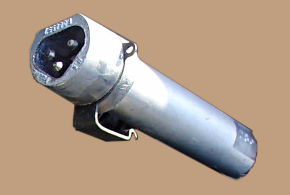
Small images are linked to larger versions.

|
|
The 2010 and later third-generation Prius engine accepts the same auxiliary
block heater as the second-generation, but installation is a little
different. This is an early account of exploring the procedure, in which
I had the honor of working with "Mr. Block-heater" himself, Wayne Mitchell
aka FireEngineer, who's gone all over the country and done on the order of
150 installations for people in their second-generation Priuses. I'm sure
that the process will undergo several refinements and speedups, but here are
the early discoveries about accessing the new location -- which isn't really
new, it's the same place on the engine block but just a little more buried
under other stuff.
Small images are linked to larger versions. |
|
Wayne and I actually muddled our way through doing the first car without
removing the wipers and cowl. Installation was successful, but when it came
time to do his own, for completeness and better access [and pictures!] we set
to and tore his car apart quite a bit more. Wayne did most of the necessary
steps himself, so he'd learn the process, while Mike Sirach and I buzzed
around with cameras documenting it.
Many comparisons are made to cowl removal and heater installation in the second-generation cars, which are described here for reference. There's also a long-running thread on Priuschat about different methodologies and subtleties for the second-gen with many pictures that other people have contributed. One of the great things about the Prius in general is the knowledgeable online community that comes with it. Metro Toyota is still the best place to order the heaters from. It may be necessary to contact them [e.g. Jesse who works there] and ask specifically about it. The Priuschat online store also offers them, subject to availability. |
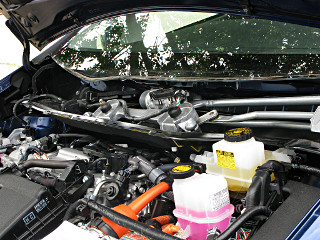
|
The wiper mechanism is a little different, but similarly bolted in with rubber spacers to give the whole assembly a little flex. The wire to the wiper motor goes up at the right side now. |
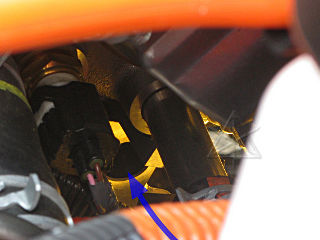
|
With the wiring sufficiently pushed aside, we can finally *see* the block heater hole. The yellowish light is coming from a bulb behind the engine block, which helps lend a little perspective. It's all about the lighting, y'know. |
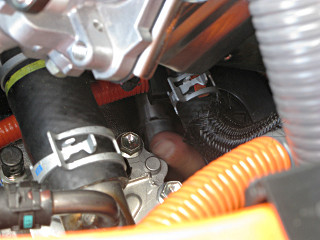
|
After a quick test-fit, the heater can be greased up with its included thermally-conductive goo, and inserted for real. There's Wayne's finger sliding 'er home. |
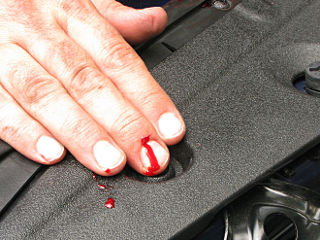
|
That's no guarantee against getting scraped up by some piece or other, as Wayne proved by once again leaving his DNA all over another Prius as this new 2010 drew first blood. It's traditional by now. |
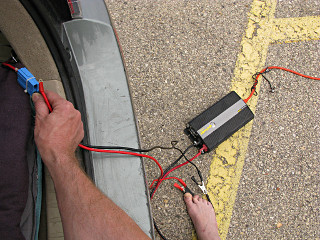
|
To test the installation, the heater needs to be powered and the boss where it goes on the back of the block felt for warmth. We didn't have utility power out here and my little inverter isn't quite up to supplying 400 watts, but Wayne had a 1000 watt inverter and a couple of clip-cables for it, and I simply held the ring terminals into my Anderson connector long enough to supply power and test the heater with it. Only took a few seconds, until Wayne said "ow, that's hot!" Managed to avoid setting my sleeping bag on fire during all this... |
|
This treatise deliberately leaves out anything about how to route the power
wire. That's a choice totally up to the owner, since there are so many
different ways to do it. The typical path up past the inverter toward
the front, down behind the nosepiece, and out through slots in the front
grille works fine and gives ample tie points. Others may want to keep
the plug farther inside the underhood area and bring the power feed cord
in to that point. It's a wire -- do what you will to it, but also see the
caveat about cordset robustness below.
Disassembly steps can be reversed to put everything back together. Make sure to plug the resolver connection back in, or the car will be quite unhappy! The wipers need to be carefully aligned on their shaft splines to avoid stripping them; wiggling each wiper arm while slowly hand-snugging down the nut makes sure they're seated correctly. |